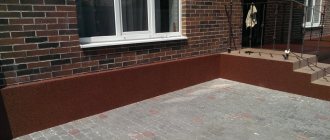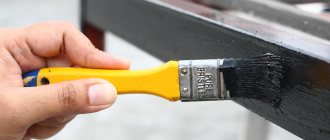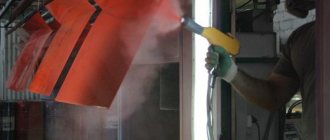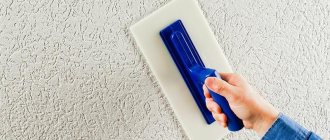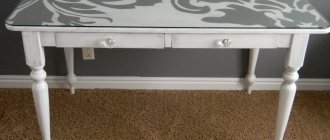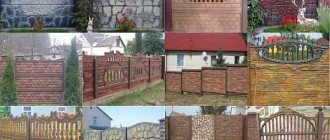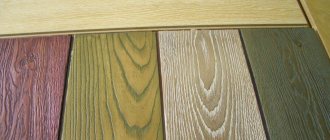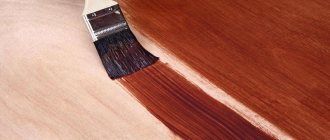Reasons for the need to paint a slate roof
This roofing material, which can be flat or wavy, was quite often laid on roofs and is often still preferred today due to a number of its inherent positive qualities and availability, but over time, due to a number of negative environmental influences, not only its appearance deteriorates, but also decrease in initial technical indicators.
If you are bored with the dull gray color of slate or only because of its primary shade you have to consider and make a choice towards other options, then the way out of this situation is to paint asbestos-cement sheets. In addition, it is necessary to coat the roofing material with paint for a number of the following and no less important reasons:
- Slate contains asbestos dust, which is hazardous to human health. By applying a layer of paint, which acts as an additional binder, it is possible to increase its level of environmental safety, preventing its weathering.
- Quite high porosity. Because of this, the material is prone to the occurrence of microcracks, which during painting, along with the pores, can be filled with a coloring composition, which simultaneously allows increasing its waterproofing properties. Otherwise, water easily penetrates into them, which in the cold season is converted into ice, which leads to disruption of the integrity of the slate fibers.
- Eliminating the possibility of moss and lichens appearing. A similar problem is faced by many owners who, instead of covering the roof with metal tiles or other roofing material from among the available options, still decide to nail slate onto it. In this case, painting allows you to get rid of existing pests and avoid the occurrence of such pests that live on the porous surface of asbestos-cement sheets.
- Gaining smoothness. The roofing material also receives this useful property after being coated with paint, due to which it does not retain atmospheric precipitation and snow easily melts off, which increases the load on the sheathing and its rafters. This plays a significant role, since asbestos-cement sheets themselves have quite a large weight. If dirt appears on the roof, you can always clean the slate on it by watering it with a hose or using a portable car wash.
- Appearance. With the help of coloring compounds, you can give the roof the desired color, which can harmoniously combine with the facade of the house and complement it.
- Increased technical performance and service life of the material. As a result of staining, slate more resistant to frost, moisture and temperature changes, and also increases its resistance to various loads and other adverse environmental influences, which has a positive effect on the service life of such a roof, allowing it to be used for a much longer period of time .
Note! By periodically painting a slate roof with paint, it is possible to increase its service life by about 1.5 times or even more.
From all of the above, we can draw a completely logical conclusion that covering the roof with a coloring composition has a positive effect on it as a whole, which is why it is highly desirable and best to do it before installation work is carried out. Usually, things are different, and in most cases, such a need or desire to change the color arises only several years later (usually 5-7) after laying slate on the roof, which is why it is necessary to carry out additional preparatory measures before applying paint to finish material to the required condition.
What paints are best for slate? Manufacturer and price
Do not forget that the quality of paint often depends on the manufacturer. The more reliable and popular the latter, the less likely you are to end up with bad products. But there is a downside to this, as their offerings often have a higher cost compared to lower quality alternatives. And here you have a choice, since on the one hand, slate painting is carried out in order to save money and not replace the coating with a more expensive one. On the other hand, you will not get the desired effect from a cheap product. Therefore, we recommend getting to know the market leaders in this category.
On the domestic market you will find a huge number of options, both from manufacturing companies in the CIS countries and from foreign ones. Among the first, paints from Butanit, Polifan and Unisal deserve special attention. All of them are distinguished by good resistance to weathering, ultraviolet rays and will retain their original appearance for a long time. Among foreign manufacturers, Germany is in first place with the Dachbesischichtung brand, which offers excellent paint for creating durable coatings. In addition, you should not pass by the Finnish Kilpi and the Polish Polifarb. They are excellent acrylic paints with a short drying time.
How to paint slate on the roof of a house: choosing a coloring composition
The selection of paint must be approached extremely responsibly, since the final appearance of the painted roof, as well as the properties that it will acquire as a result, largely depends on it. In addition, not each of them is optimal for slate coating, which should also be taken into account, because otherwise the applied layer may last an extremely short amount of time or will not have the necessary qualities to ensure protection and elimination of microcracks present in it.
Among the suitable mixtures are the following types of paints:
- acrylic;
- silicone;
- alkyd;
- polymer.
Each of the varieties has its own positive and negative properties, which is why, before making the final choice towards one or another mixture, it is better to consider all of them in detail in advance in order to ultimately choose the most suitable one for yourself.
Acrylic paints
They are in extremely high demand, largely due to their largest range of available colors and shades, differing in their intensity and level of matte. There are two types of such mixtures on sale. In the first case, they are water-soluble (water-dispersible), and in the second, they are made on the basis of organic solvents. Their properties also differ, which is why you also need to familiarize yourself with them first.
Water-based acrylic paints
In the production of mixtures of this variety, latexes (acrylic copolymers), coloring pigments and a number of other additives are used that help improve the technical performance of the compositions. The latter components include biocides, antifreeze and others. In addition, in their production, water is used, acting as a diluent and solvent, the volume of which is in the range of 5-15% of the total.
The positive aspects of water-based acrylic paints are a number of the following properties:
- No toxins. Thanks to this, when applying the mixture there is no release of an unpleasant odor.
- Ecological cleanliness. In the production of water-based acrylic paints, no components hazardous to human health or the environment are used.
- High drying speed. Complete hardening of one layer of paint takes about 1-2 hours.
- Easy to apply. During the painting process, no drips appear on the surface of the materials.
- Before use, there is no need to additionally add a special solvent to the container with them.
- High resistance to fire. This is due to the paint content, which contains water.
- Helps increase the frost resistance of slate.
- Low consumption. For painting 1 sq. m requires about 200-300 ml of mixture.
- High level of adhesion. Water-based acrylic paints adhere perfectly to the surface of various building materials, including slate.
In addition, when painted with it, a waterproof film is formed on the slate sheets, which provides resistance to rain and other precipitation, and also eliminates the release of asbestos dust. The service life of a coating made with this mixture reaches about 5 years.
Acrylic paints based on organic solvents
Such mixtures contain acrylic resin, additives, color pigments, as well as an organic solvent, which in most cases is white spirit. The first component directly affects the level of dullness of the paint. The more acrylic resin in the mixture, the more pronounced the gloss.
Compared to water-dispersed acrylic paints, they are characterized by increased elasticity, water-repellent properties, strength of the film formed, light fastness and long-lasting preservation of the intensity of their own color. In addition to their positive properties, they also have some disadvantages, such as the release of a gradually dissipating pungent odor, which is why it is necessary to use a respirator during their application.
The range of acrylic paints based on organic solvents is less extensive; they are characterized by slower drying, which occurs over 10-24 hours, and during the painting process such mixtures have a slightly increased consumption, reaching about 250-350 ml per 1 sq. m.
Silicone paints
Such coloring compositions are distinguished by their longest service life, which is why they are excellent for painting slate roofs. In their production, pigments and organosilicon binders are used, which provide the mixture with special strength and elasticity, and only thanks to them is it possible to eliminate cracks, the width of which reaches 2 mm.
Silicone paints have high waterproofing and dirt-repellent qualities, and in the case of painting slate with them, it is possible to eliminate the need for preliminary priming. The components present in their composition prevent the occurrence and reproduction of various unfavorable microorganisms on the surface of the roofing material, which leads to deterioration in appearance and even damage to the integrity of the sheets.
For this reason, it often becomes necessary to repair holes or cracks in the slate, and in particularly difficult cases, replace it altogether, often prematurely. Silicone-based mixtures also do not contain toxins, so during application they do not emit an unpleasant odor that is dangerous to human health. Such compositions are fireproof and have an extended service life, reaching about 10-15 years.
Silicone paints adhere well to the slate surface, but during the specified period of operation they are subject to severe fading under the influence of sunlight, losing their original attractive appearance, which still happens long after painting. In addition, the cost of such compositions in comparison with other mixtures is an order of magnitude higher than most of them, which should also be taken into account when choosing.
Alkyd paints
Their production is carried out using alkyd resins, pigments and organic solvents. Alkyd enamels are characterized by high resistance to moisture and precipitation, the presence of an increased level of adhesion to the slate surface, and also make it possible not to necessarily treat the roofing material with a primer during preparatory work.
Such mixtures do not cause any difficulties during the application process and their complete drying occurs within an extremely short period of time, which generally varies from 30 to 90 minutes. Due to the fairly high elasticity inherent in alkyd paints, cracks do not occur on the film formed on the surface of the roofing material as a result of painting them throughout the entire period of operation.
Another significant advantage is the ability to tint the mixture, which is sold in white. Basically, when painting a roof, preference is given to compositions of green, red, blue and brown shades, but in view of this feature, you can always make a choice not only of these, but also of any other desired tones that may not be on sale, the main thing is that it is harmoniously combined with facade of the house and corresponded to personal taste.
You can tint the paint either using special equipment, using the service in stores that have it, or with your own hands at home. In the second case, in addition to the mixture itself, you need to purchase a suitable color, and then use a mixer or drill to mix them while adding a coloring pigment, which, to achieve the optimal shade, should be added to the container gradually in small portions.
The main disadvantages of alkyd enamels are low resistance to fire and alkalis, due to the use of drying oil, turpentine, white spirit and solvent as thinners, as well as a short service life, which often does not exceed 5 years.
Polymer paints
Often referred to as “Liquid plastic”, which acquired this name due to the content in its composition of a suspension of various polymers that act as a base. Among them may be polyvinyl chloride, polystyrene and polyurethane. In addition, such mixtures contain pigments, special additives that help improve the technical performance of polymer paints, and a synthetic solvent.
After painting the surface of the roofing material, the last component volatilizes. The polymers, in turn, dry and as a result acquire their final optimal hardness, creating a thin coating of plastic on the slate. The surface itself ultimately has a visual matte or glossy effect.
As a result of staining with them, a completely moisture-resistant coating appears on the slate, preventing the penetration of water into the roofing material. Polymer paints do not fade under the influence of sunlight and withstand precipitation.
When using them, it is not necessary to pre-prime the slate surface. Such mixtures are highly frost-resistant and provide the opportunity to carry out painting work even at temperatures as low as -10°C.
In addition, polymer-based enamels require a very short amount of time to dry completely. Usually it happens in about 30 minutes. The resulting coating is not subject to combustion, resistant to chemicals and has a long service life, reaching 10-15 years.
The only significant drawback of mixtures of this variety is their toxicity, which is why when painting slate with them it is imperative to use a respirator and ensure skin protection.
After familiarizing yourself with the features of the main types of paints, through which in most cases the color of the roofing material is changed, you should choose the most suitable option for yourself, which is what you will have to purchase in the future.
Preparatory work
Before painting the slate on the roof of a house, it is imperative that they be carried out, since they have a significant impact on the final result and often on the service life of the coating applied to its surface as a whole. Otherwise, there is a high probability that the composition will not be able to serve the allotted period of time. As a result, cracking, swelling and peeling of the coating may occur ahead of schedule. In some situations, this can even happen several days or weeks after the coloring has been completed.
Taking this into account, the preparatory work must be completed and each stage must be done efficiently, especially when it is necessary to paint not only the purchased new one, but also the roofing material previously laid on the roof, which has already been in use for several years and has been repeatedly exposed to various adverse environmental influences.
If the slate installation was completed a long time ago, then there is a high probability that moss has grown on it at least on the northern side of the roof, which must be completely removed before painting work, along with other existing dirt, debris and dust.
Note! Properly performed preparatory work allows you to achieve uniform coloring and give the roof a more attractive appearance, which it will not lose for many years.
There are several ways to deal with them. Each method must be performed using different tools and observing certain nuances. You can get rid of dirt and moss using:
- Hand tools. Basically in this case a metal brush is used. When carrying out work with it and other similar devices, which are scrapers, brooms and their analogues, you have to spend a lot of effort, and the process itself takes a huge amount of time. Using a wire brush or other chosen tool, you need to carefully scrape off efflorescence, moss, lichens and other contaminants present on the surface of the slate. The positive side of the method is that there is no need to use special devices, the purchase of which leads to an increase in overall costs.
Note! In order to avoid accidental damage to the roofing material, it is necessary to carry out preparatory work only in dry weather, when the slate is fully dried, since being in a wet state, it is more fragile.
- Electrical tools. In this situation, when removing moss and other vegetation from the roof surface, a grinder or a drill is used, on which a special attachment is installed, also in the form of a metal brush.
To eliminate the possibility of damage to the slate, cleaning work must be done while avoiding strong pressure on the tool. With their help, it is not possible to achieve a significant increase in the speed of work performed, but thanks to them, the final result of such influences is of higher quality in comparison with manual devices. - Specialized washes. The most favorable method for removing debris, dust, as well as various types of contaminants and microorganisms from the slate surface. The process itself occurs during the use of washers that supply a stream of water under high pressure. The best option is to use equipment that produces 200-250 atmospheres. With a pressure of lesser force, in most cases it is not possible to fully cope with the task, and if it is higher than the specified value, then it is highly likely that not only the removal of moss and dirt will occur, but also damage to the roofing material itself.
Cope with washing a roof covering an area of 100 square meters. m using such equipment is quite possible in 1-2 days, which is several times faster than when carrying out work with hand or electric tools.
Important! Regardless of the method that is preferred, it is mandatory to clean slate using special clothing, a wet respirator, as well as safety glasses and gloves that provide protection from asbestos dust that is hazardous to health.
After cleaning the roofing material, you need to carefully inspect it for damage. If detected, in order to avoid further leaks, holes in the slate and cracks should be repaired, and if necessary and possible, replace sheets with such defects with new ones.
Note! Before proceeding to the next step, if you use a sink, you must wait until the roofing material has completely dried.
Next, you need to treat the slate with a general-purpose antiseptic or one designed exclusively for it. With a brush, roller or spray, it is necessary to apply it to the entire surface of the roofing material and it is advisable to apply several layers.
Important! If in the future you plan to treat the roof with a primer with antifungal properties, then it does not need to be applied.
After the antiseptic is completely absorbed, in addition to it, you need to coat the roof with a water-repellent agent, which will provide complete protection of the slate from water, which negatively affects its porous structure.
Coating slate with primer
Even if further painting is to be done with paint for which treatment with a primer is not a mandatory requirement, its application in any case will not be superfluous and is still desirable, especially when preparing old roofing material. The mixture must be selected in accordance with the paint selected for painting. By coating the slate surface with a primer, it is possible to increase the level of adhesion, reduce paint consumption and increase its service life.
Note! When painting slate sheets with acrylic paint, they must be pre-primed.
In addition, such a mixture allows you to protect the roofing material from the negative effects of fungus and other dangerous microorganisms, which over time can lead to the destruction of its structure. If the slate affected by them is simply painted without pre-treatment with a primer, then they will remain and will still have an adverse effect. As a result, they will cause peeling of the coating applied to the roof surface, and the formation of an outwardly unattractive black or white coating.
The best option is to use a deep penetration primer designed for slate or matching the coloring composition. The mixture can also be applied using a paint brush, spray gun or roller. The last tool is convenient to use only when processing flat slate. If you have to prime a wavy roofing material, it is better to use a wide brush or a spray bottle, which allows you to reduce paint consumption.
It is advisable to treat the surface with the mixture in 2 layers. Each of them must be fully absorbed into the slate before applying the next coating, including that consisting of paint. The primer must be applied evenly in a continuous layer, excluding any gaps. All cuts and edges of the roofing material should also be thoroughly treated with the mixture.
It is best to carry out application early in the morning, calculating the time in advance in such a way as to complete the work completely before hot weather. It is most favorable to treat the roof on a non-sunny day at a temperature of about +20°C and humidity in the range of 40-60%.
Such conditions are more suitable for humans, but in practice they can only sometimes be found, which is why the main thing is to adhere to the manufacturer’s recommendations specified in the instructions on the container. In general, it is usually allowed to carry out work at temperatures ranging from +5 to +30°C. Complete drying of the primer usually takes about 12 hours, after which you can begin painting the slate.
Note! If you just have to lay roofing material, then painting it is much more comfortable and easier, and therefore faster, than when performing the same procedure while at a height.
Painting slate on the roof of a house
It is done in the same way as priming. When painting, it is also optimal to use the same tools and apply paint in two layers, which in most cases are more than enough, the main thing is to observe the break recommended by the manufacturer of the composition in between them, which is required for their complete drying. The first coating acts as the main one. When applying it, it is necessary to ensure that all irregularities and other defects present on the slate surface are painted over.
Important! Slate painting must be done from top to bottom, and also in compliance with safety precautions, using a safety rope and performing work with several assistants.
Taking this into account, it is extremely important to use the mixture to perform high-quality treatment of joints, corners, ends, as well as gable and ridge elements of the roof. The second layer is the final one and when applying it, it is necessary to achieve the most uniform coloring of the roofing material with the absence of streaks, smudges and other visually noticeable defects, giving it the desired attractive appearance. If, however, two coatings are not enough, then if necessary, you can treat it a third time, although if the work is carried out correctly and high-quality paint is used, such a need arises extremely rarely.
After finding out how to paint the slate on the roof of the house and purchasing all the required materials, you can begin to carry out the preparatory work, and then the main work, following the sequence of actions and all the accompanying nuances, which will allow you to make the roof with your own hands visually attractive, harmoniously combined with the facade of the house and pleasing to the eye for many years.
Video:
Applying primer before painting
The next step will be to directly apply the primer to the slate itself; it will ensure good paint application, stability and uniform distribution over the surface. The priming process can be done using a sprayer, roller or brush. For the most uniform application, you should use several brushes of different sizes, which will ensure complete coverage of the entire slate surface with primer. Using a roller is not very convenient due to the fact that the slate surface has a twisted relief shape. You can use a spray bottle. It will save you time, but you should go over it two or three times to ensure complete and even coverage of the primer. Asbestos-cement surface materials are suitable for ground covering. Try to choose a primer that has antifungal and antiseptic properties, this will give you an extraordinary benefit and will extend the life of your slate roof.
